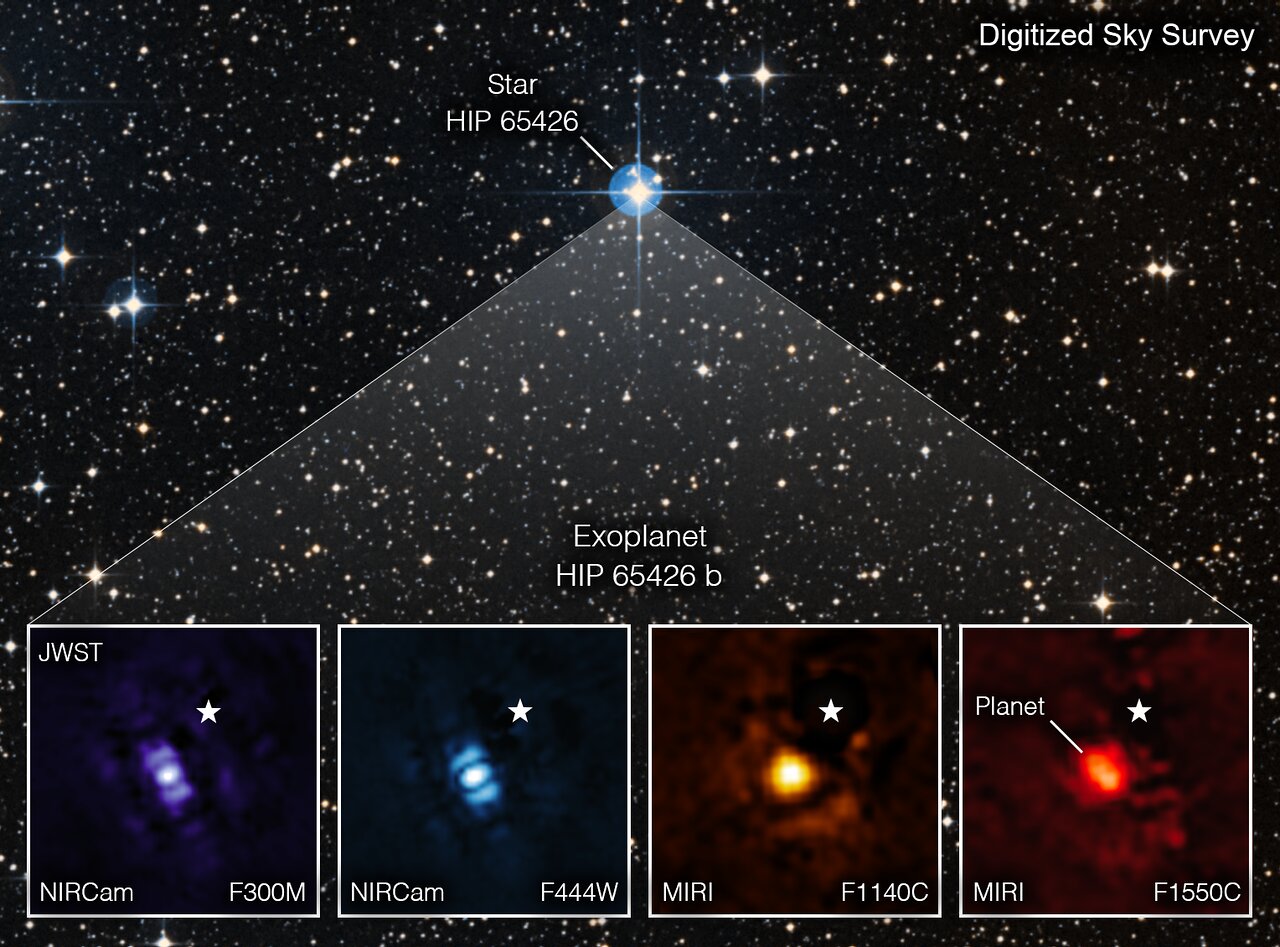The James Webb Space Telescope has taken its first direct image of an exoplanet, a planet outside our Solar System. The exoplanet, HIP 65425 b is a gas giant that orbits an A-type star, has a mass of about nine times that of Jupiter and is about 355 light-years from Earth. While the planet has virtually no chance of being habitable, the data from these observations show just how powerful a tool JWST will be for studying exoplanets.
“This is a transformative moment, not only for Webb but also for astronomy generally,” said Sasha Hinkley in a NASA blog post. Hinkley is associate professor of physics and astronomy at the University of Exeter in the United Kingdom, who led these observations with a large international collaboration. The team’s preliminary science paper has been posted on arXiv.
The planet was originally discovered in 2017 by the Very Large Telescope in Chile, which took images of it using short infrared wavelengths of light. Astronomers were interested in looking at this planet with JWST, as the telescope’s ability to view in longer infrared wavelengths can reveal new details that ground-based telescopes wouldn’t be able to detect.
This is not the first direct image of an exoplanet taken from space. Over 20 exoplanets have been imaged previously by the Hubble Space Telescope and ground-based telescopes like the Gemini Planet Imager. But this first exoplanet image from JWST showcases the upcoming possibilities for studying distant worlds.

The new observations of this planet were part of JWST’s Early Release Science Program, which allows astronomers – and the public – to have immediate access to early data from specific science observations by JWST. The public can see and understand the amazing array of science that this telescope is capable of, and astronomers around the world will have the opportunity to analyze the data and plan follow-up observations.
Additionally, these first observations with the new telescope allows astronomers to understand how this telescope performs and what they can achieve with their observations. In their pre-preprint paper, the team writes that their observations with JWST, HIP 65425b is clearly detected in all seven observational filters, and this represents the first ever direct detection of an exoplanet beyond 5 microns. In fact, the team made observations at 11.4 and 15.5 microns, which is an enormous technological leap.

The team also wrote that these first observations provide a variety of insights into the performance and best practices of JWST. They found that JWST is “exceeding its anticipated contrast performance for both NIRCam and MIRI” and that the “photometric observations of HIP 65426 b provide exquisite sensitivity” … demonstrating “that JWST provides a transformative opportunity to study exoplanets through high contrast imaging.”
Taking direct images of exoplanets is challenging because stars are so much brighter than planets. But JWST carries coronagraphs to enable direct imaging of exoplanets near their stars. The image of this exoplanet is just a “spot,” not a grand panorama, but by studying that spot, astronomers can learn a great deal about it. That includes its color, differences between the seasons, its rotation and if there might be different seasons and weather.
HIP 65426 b planet is more than 10,000 times fainter than its host star in the near-infrared, and a few thousand times fainter in the mid-infrared. Astronomers said that in each filter image, the planet appears as a slightly differently shaped blob of light. That is because of the particulars of Webb’s optical system and how it translates light through the different optics.
“Obtaining this image felt like digging for space treasure,” said Aarynn Carter, a postdoctoral researcher at the University of California, Santa Cruz, who led the analysis of the images. “At first all I could see was light from the star, but with careful image processing I was able to remove that light and uncover the planet.”
One of the keys for JWST’s observations is its ability for spectroscopy, which is the science of measuring the intensity of light at different wavelengths. When a planet passes in front of a star, the starlight passes through the planet’s atmosphere. Astronomers explained that if, for example, the planet has sodium in its atmosphere, the spectrum of the star, added to that of the planet, will have what is called an “absorption line” in the place in the spectra where sodium would be expected to be seen. This is because different elements and molecules absorb light at characteristic energies; and this is how we know where in a spectrum we might expect to see the signature of sodium (or methane or water) if it is present.
One of the main uses of the James Webb Space Telescope will be to study the atmospheres of exoplanets, to search for the building blocks of life elsewhere in the Universe. The benefit of making infrared observations is that it is at infrared wavelengths that molecules in the atmospheres of exoplanets have the largest number of spectral features. The ultimate goal, of course, is to find a planet with a similar atmosphere to that of Earth.
While HIP 65426 b is not like Earth at all – a gas giant that takes 630.7 years to complete one orbit of its star, and is 92 AU from its star – it does give astronomers their first ‘hands-on’ experience with imaging and observing exoplanets with JWST.
As the team wrote in their paper, “In totality, these observations confirm that JWST presents a powerful and exciting opportunity to characterize the population of exoplanets amenable to direct imaging in greater detail.”

